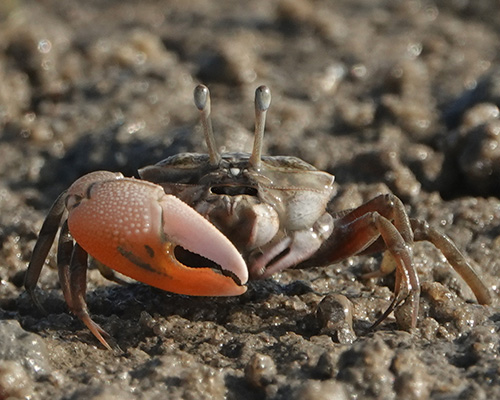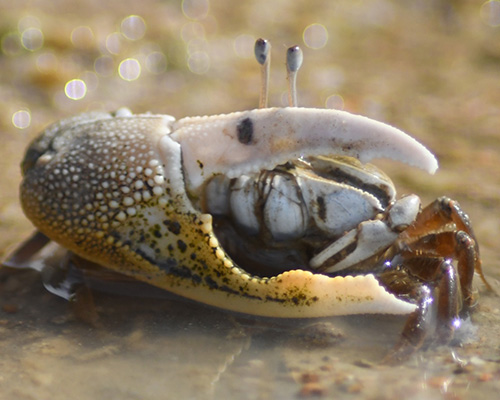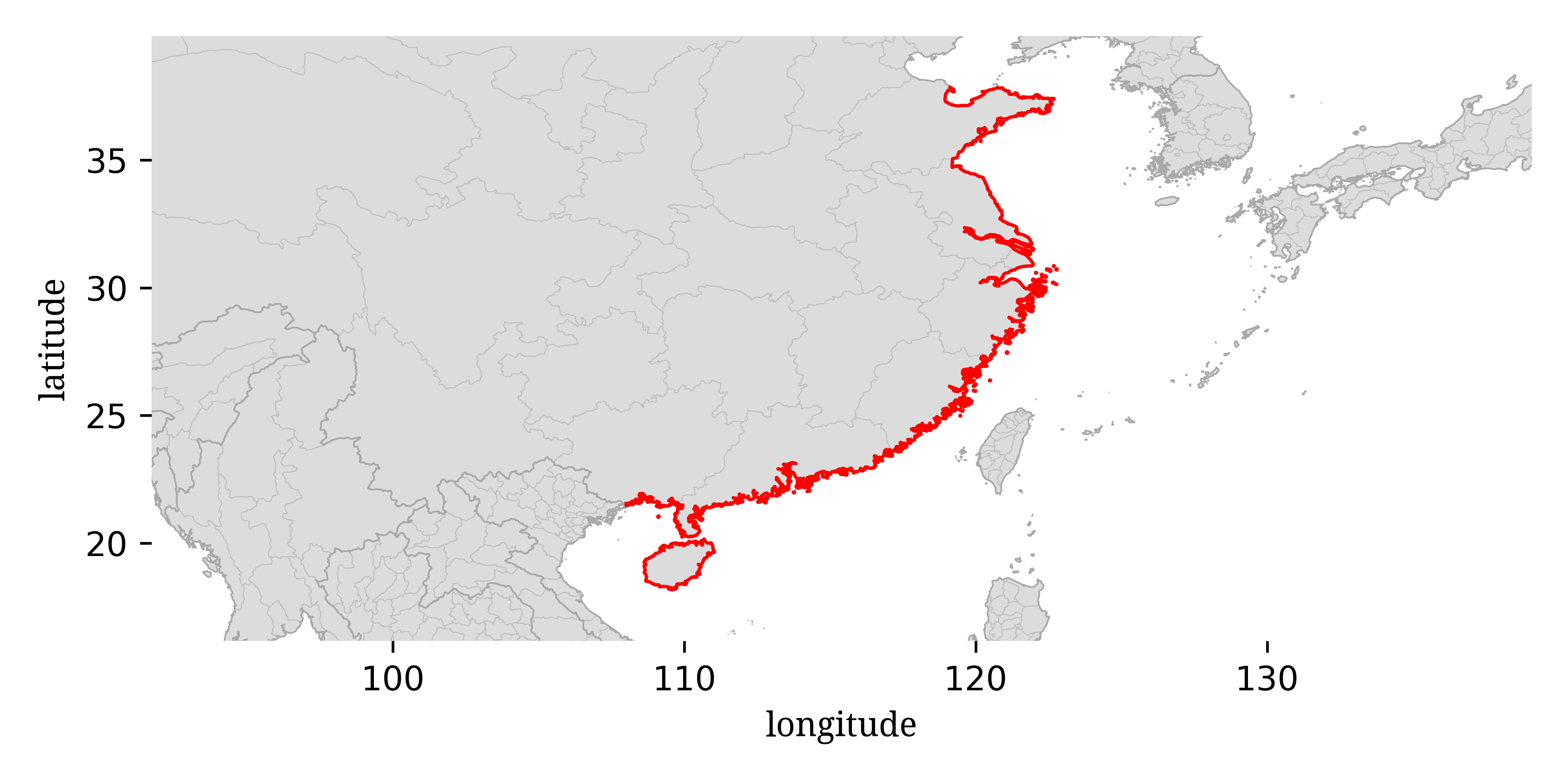
This guide is designed for identification “in the field” where you might be looking at live crabs by eye or through binoculars or from photographs. I will generally try to avoid characters that will require you to physically catch the crab, although I may mention a few for secondary verification. It does not include the more strict taxonomist-style characters that may only be visible under a microscope or via dissection. It is also assumed that the individuals are living, as death (and even capture) can cause dramatic color change.

This particular guide was aided by a guide in Chinese written by Chengyi Liu and colleagues which can be found here: 中国大陆及海南岛常见招潮蟹识别指南.
This is a guide to the fiddler crabs of mainland China and the islands of Hainan and Kinmen (Taiwan). While there is overlap, it would not serve as a full guide for more distant islands or Taiwan. Nine primary species are found within this region:
All of these species are found in Hainan and most are found along the southern coast of China, but many do not extend all the way north. Specific distributions will be mentioned for each species.
A few other species have been reported from this region, but are either extremely rare or represent very questionable records.
A number of features can be used to distinguish among these species, but a good place to start is to look at the distance between the base of the eyestalks. Fiddler crabs tend to split into two groups, those with the eyestalks very close together (“narrow front”) and those with the eyestalks separated a bit more (“broad front”). Three of these species (Austruca annulipes, Austruca lactea, and Paraleptuca splendida) are broad front species, while the other six (the two Gelasimus and four Tubuca) are narrow front species. Note that the carapace between the eyestalks appears pinched together in the narrow front species, but more trapezoidal in the broad front species.
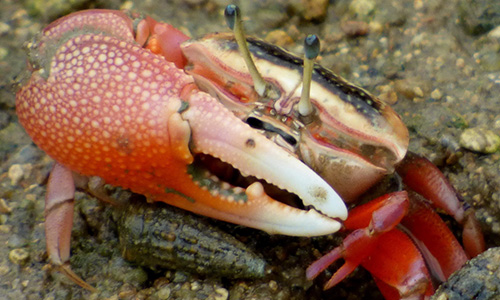
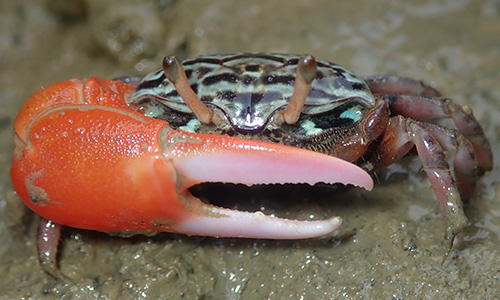
The three broad front species are fairly easy to tell apart. Paraleptuca splendida is fairly distinct, while the two Austruca or more similar to each other but still generally have obvious color differences, particularly among the males (females in isolation are much more difficult).
Paraleptuca splendida are the easiest of the three broad front species to identify. The carapace is generally a marbled aqua (blue) and black, sometimes with a patch of red behind the eyes; occasionally the blue fades to more of a tan color. The legs are usually red (although sometimes more blue/tan/black striped). The major claw of the males is red, with paler pink fingers. Most importantly, the eyestalks are almost always red or red-tinted. A broad-front with red eyestalks is generally sufficient to identify this species.
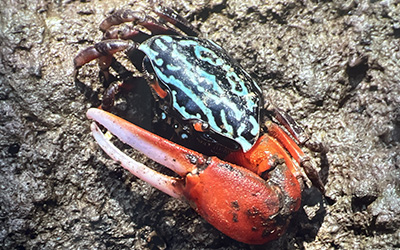
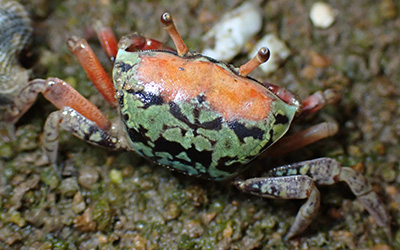
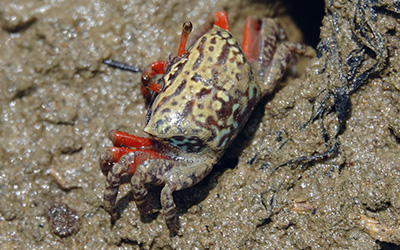
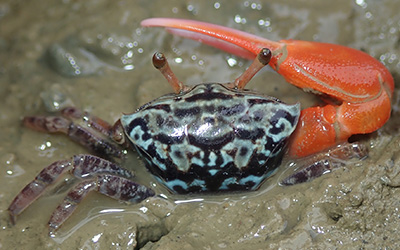
Within China, Paraleptuca splendida is found along the southern Chinese coastline as far north as the Fujian Province.
Along most of the Chinese coastline, the only other broad front species is Austruca lactea, however the closely related species Austruca annulipes is also found on Hainan Island, so care must be used in distinguishing these in that region.
The carapace of Austruca lactea is generally either white or white with black (dark brown) markings, generally a small scattered speckling of black, frequently with a few thin stripes (kind of like a Rorschach test). In rare occasions the carapace will be more black than white. The legs are generally either white or red (ranging from dark to bright). Eyestalks are generally white or gray. The major cheliped is generally entirely white, or with yellow extending from the arm up into the hand of the claw, but usually still white along the fingers.
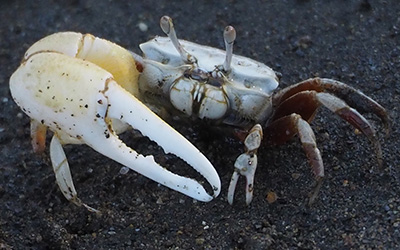

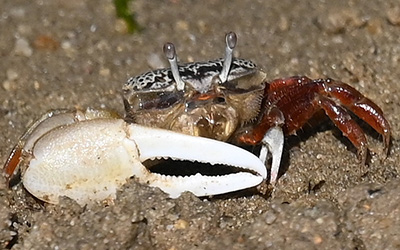
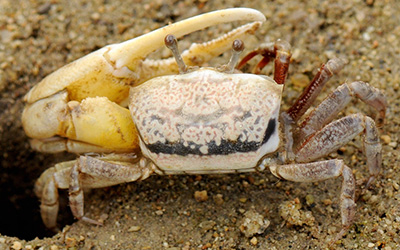

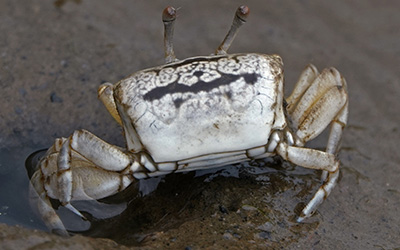
The species Austruca perplexa can be very similar in appearance to Austruca lactea, but it is all but unknown from mainland China and purported observations of it are likely either errors or rare, stray individuals rather than established populations. I'm not going to include a full description here, but it is primarily distinguishable by differences in the coloration pattern of the carapace (as well as some very subtle shape differences).
Austruca annulipes is a widespread, highly variable species; within the covered region in this guide, it is primarily found on Hainan Island, with potentially some scattered observations on the mainland. Although they are fairly similar, under most circumstances one should be able to tell the two Austruca species apart without too much trouble.
The primary character that distinguishes the two species is the color of the major cheliped. In Austruca annulipes it tends to range from red to orange or pink, rather than the white and yellow colors found in Austruca lactea. As with Austruca lactea, the carapace of Austruca annulipes tends to be a mix of white and black (dark brown), but unlike the previous species, the carapace of Austruca annulipes is generally more an even mix of both colors, learning toward the darker rather than the lighter, although there are some cases of almost entirely white carapaces. In other individuals, the carapace of Austruca annulipes may contain blue rather than white. The legs of the two species are similar in color, usually either red or a mix of white and black.
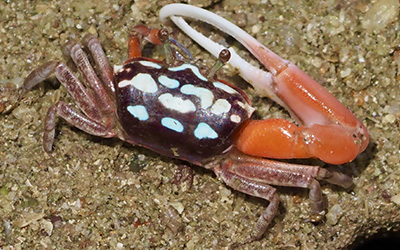
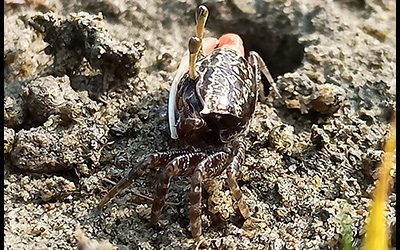
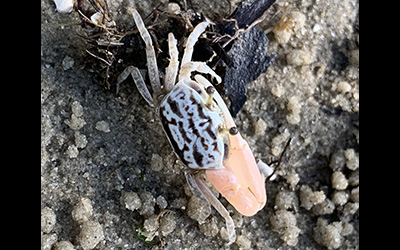
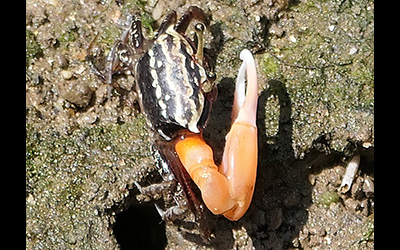
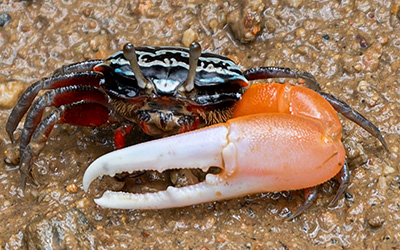
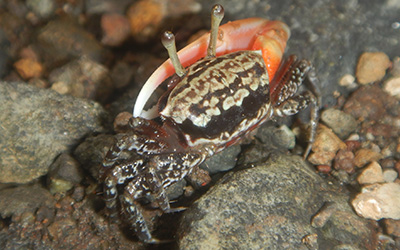
Of the six narrow front species, two are fairly distinct (Tubuca typhoni and Tubuca paradussumieri), while the other four form two pairs of similar looking species.
Tubuca typhoni is a distinct, poorly known species, only found in Hainan and parts of the Philippines. Superficially it is similar in color to Paraleptuca splendida, but the two species are quite different even beyond the broad front vs. narrow front distinction.
Tubuca typhoni has a black and blue-to-purple carapace, with much more solid patches than the striping found in Paraleptuca splendida. In females, the carapace may be more of a solid reddish-purple. Its legs and eyestalks are generally a reddish-purple; its major claw is a similar color with some whitening along the tips of the fingers. The shape of the major claw is often more distinctly bowed than in Paraleptuca splendida and the ends of the fingers often end in a pair of flat surfaces rather than pointier tips. Eyestalk colors ranges from purple to red to gray.
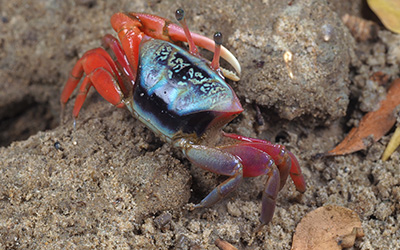
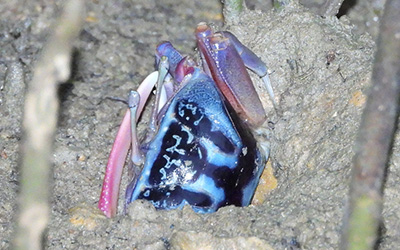
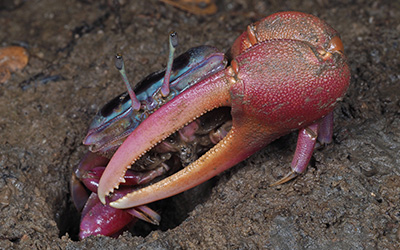
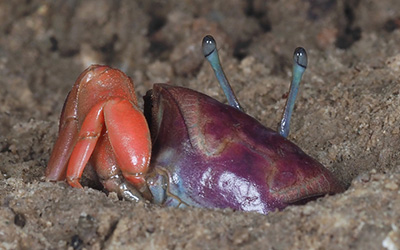
Tubuca paradussumieri, found along most of the coast of China, is a strangely variable species, but still frequently identifiable in each of its varying forms. In one common form, adults are generally a rather dull color, with a faded blue-tan carapace (sometimes light, sometimes dark) and generally yellow-tan major claw. The shape of the claw in this form is quite distinct with extremely long fingers relative to other fiddler crabs. The claw shape alone can be used to identify the species in this form.
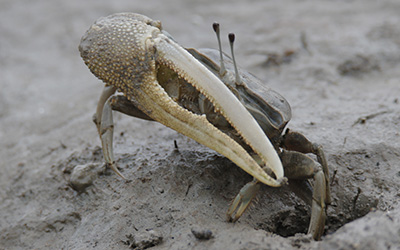
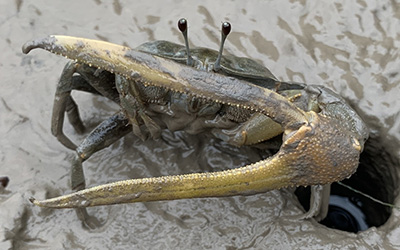
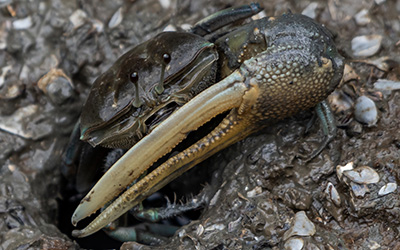
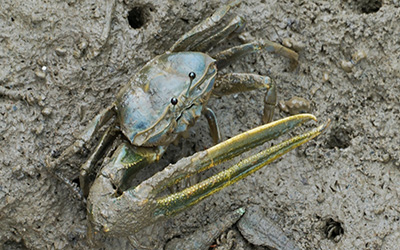
In contrast to the dull colors of these large adults, younger individuals in this species can be a brilliant cobalt blue, with much more typical-shaped claws lacking the overly long fingers. Some other related species from the genus Tubuca might also have a similar blue phase, so it is unclear how readily identifiable individuals of this shade are to the species level.
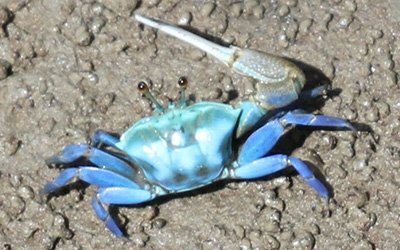
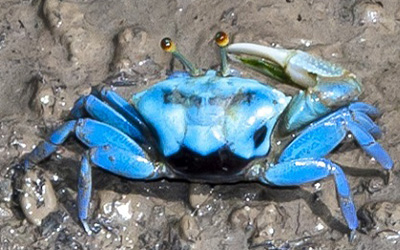
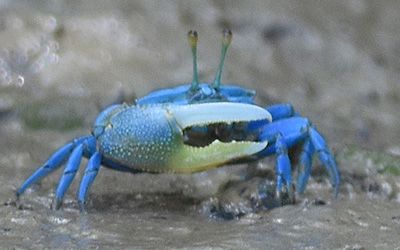
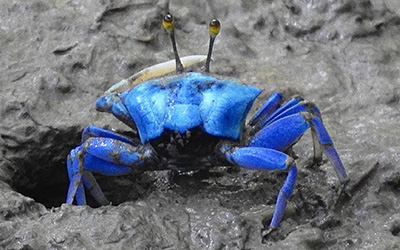
Tubuca arcuata is among the most common fiddler crabs found in China and the northwestern Pacific. The species it is most likely to be confused with, Tubuca acuta, will be described next.
The carapace of Tubuca arcuata is usually a mix of white and black, sometimes red and black, although in some individuals it may appear more solid white, black, or red. The black markings tend to be in large patches, often with a large stripe across the middle of the carapace and a second stripe toward the back of the carapace. The black sections will often appear speckled with the background color. In rarer instances, the white may appear more as a pale blue, particularly in juveniles; this blue is much paler than the bright blue of Tubuca paradussumieri. They generally have yellowish eyestalks with dark eyes.
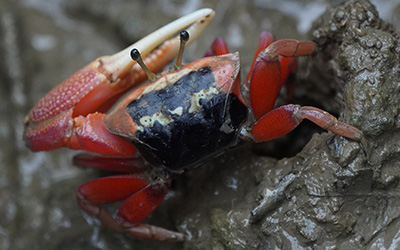

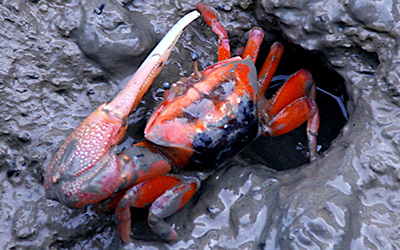

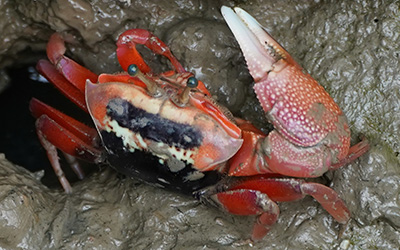
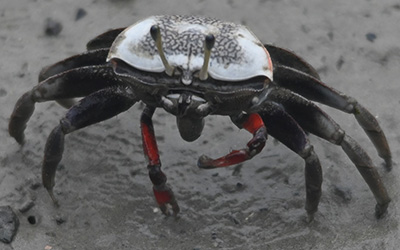
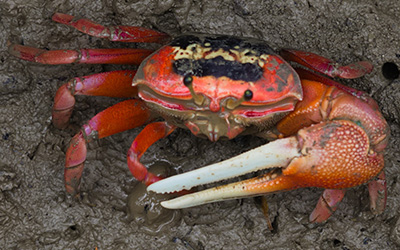
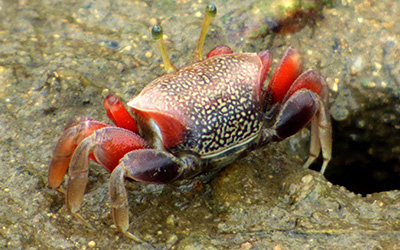
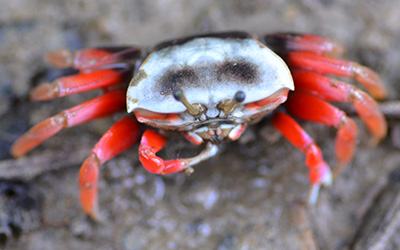
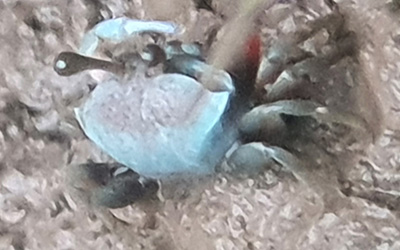
The limbs of Tubuca arcuata are usually red, sometimes black. The large claw is very robust, with distinct bumps on the outside. It is generally red, with white fingers. The fingers are usually distinctly curved and frequently meet with at the tips with flat inner surfaces. There will frequently be a distinct tooth about midway along the lower finger, and occasionally on the upper.
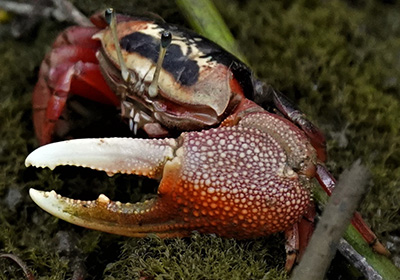
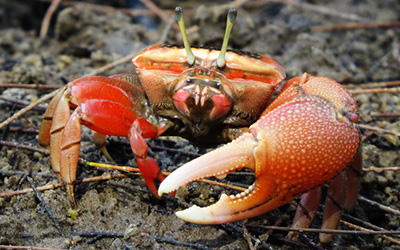
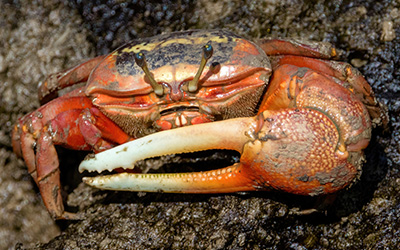
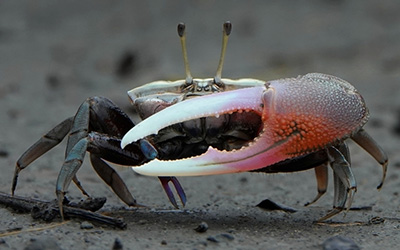
Tubuca acuta is generally similar in appearance to the more common Tubuca arcuata, with overall similar colors. As with the previous species, the carapace of Tubuca acuta is generally a mix of black and white, but the primary difference is in the patterning of the colors. In Tubuca arcuata there are commonly large patches of black on white, while the carapace of Tubuca acuta is more uniformly speckled. Contrast the photos below of Tubuca acuta with those of Tubuca arcuata above.
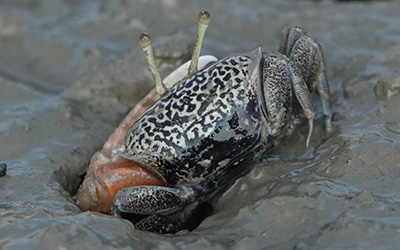
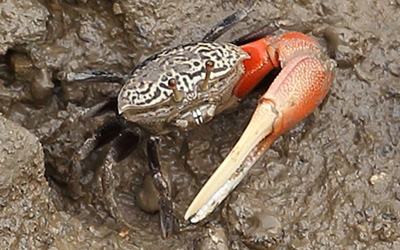
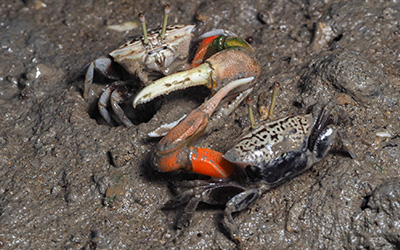
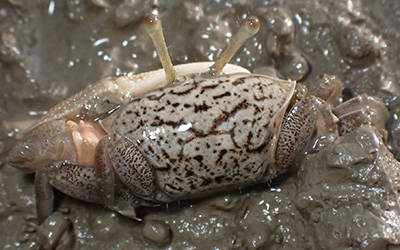
The limbs of Tubuca acuta tend to be black and white, but sometimes red, and the claw color tends to be an orange-red with white fingers. The claw structure is similar to Tubuca arcuata, but usually a bit less robust and smoother looking (less obvious bumps on the outside of the claw).
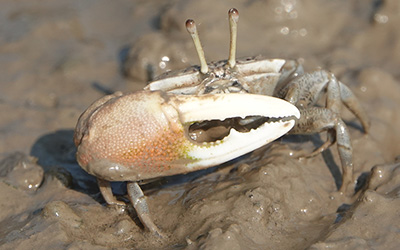
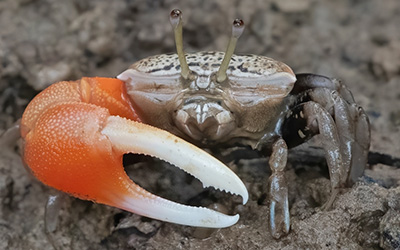
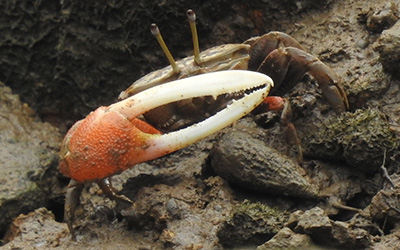
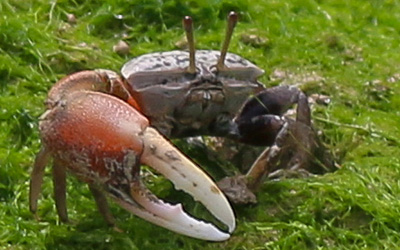
Tubuca arcuata can grow substantially larger than Tubuca acuta (approximately 3.5 vs 2.5 cm toward the upper end of their normal size range), but there is enough overlap that size will generally not be useful to distinguish them except for perhaps the very largest Tubuca arcuata. Both species are found essentially along the entirety of the Chinese coast, although Tubuca arcuata appears to be the much more common species.
Along most of the Chinese coastline, Gelasimus borealis should be easy to tell apart from other species. Only on Hainan, where it overlaps with another closely related species is there likely to be any confusion (see below for discussion).
Gelasimus borealis can be distinguished from most other species by both color and the structure of the large claw in males. The claw has a distinct shape only found in (most) species of the genus Gelasimus. Specifically, the upper finger tends to be moderately broad, tapering smoothly to a point, while the lower finger will usually curve upwards with a characteristic wave on the inner surface highlighting one to two large teeth. Individuals with regenerating claws will often lack much of this shape, but the claw still looks readily different from other species in the region.
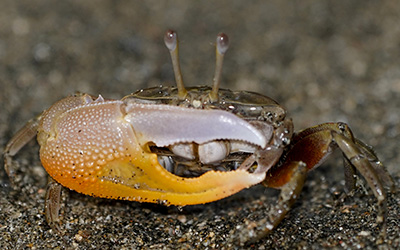
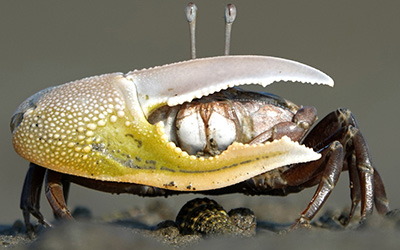
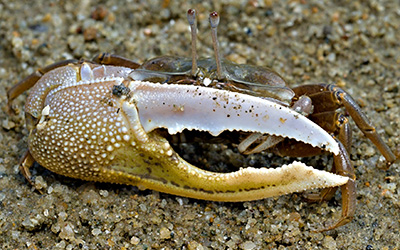
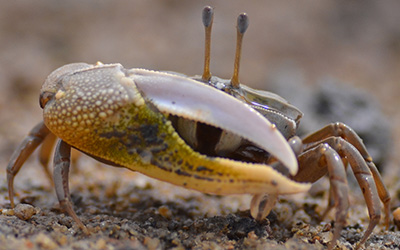
The color of Gelasimus borealis also differs from all of the other species (outside of Hainan). The carapace generally appears much more solidly colored or lightly marbled, rather than with the more dramatic patterns of other species; the color is frequently green or dark brown or white. The lower finger of the claw is typically yellow-green or orange, with the upper finger white or pink. The species entirely lacks the red common to all of the other narrow front species described so far (the orange on the claw will sometimes be reddish).
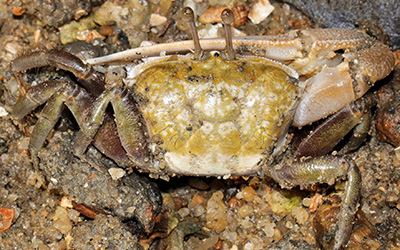
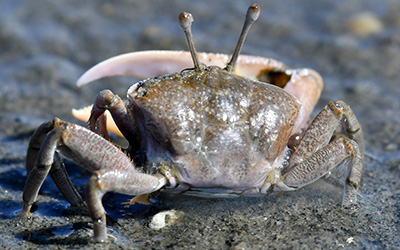
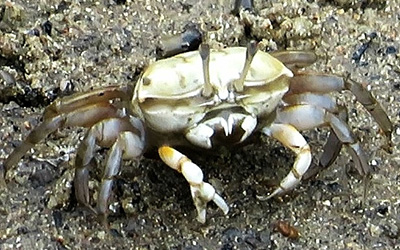
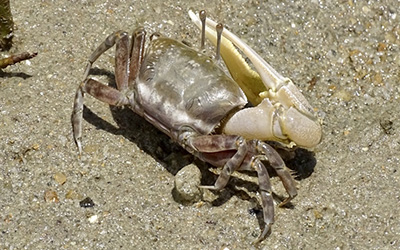
A second species of Gelasimus can be found on Hainan, Gelasimus vocans, with some suggestion that it is spreading to other parts of southern China, such as Hong Kong. It and the previous species, Gelasimus borealis, are extremely similar, so much so that we lack reliable means of differentiating them in the field. There are some subtle differences, however, that may allow identification in some cases. On males of Gelasimus vocans with classic, unregenerated large claws, the tooth pattern on the lower finger is more striking and pronounced that found in Gelasimus borealis, where the teeth are never as striking; unfortunately regenerated claws are more likely to overlap in shape and structure across the two species. Compare more dramatic shape of lower finger of claw on the below photos to the more subtle shape of the previous species.

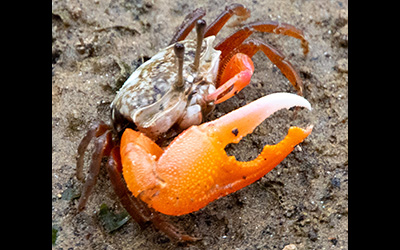

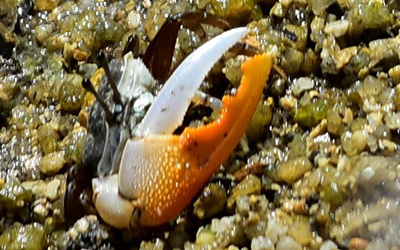
Another subtle difference which can also be seen in the above photos is that the color of Gelasimus borealis tends to be more dull, while that of Gelasimus vocans tends to be more bright and bold. Contrast the shades of orange on the claws of the two species.
A final very subtle difference which is difficult to see in the field and most photos is in the shape of the small claw on males (and both claws of females). In Gelasimus vocans the gap between the fingers of the small claw tends to be as wide or wider than the lower finger, while on Gelasimus borealis this gap tends to be narrower than the lower finger. Compare the gap in the small claws between these two sets of photos.
